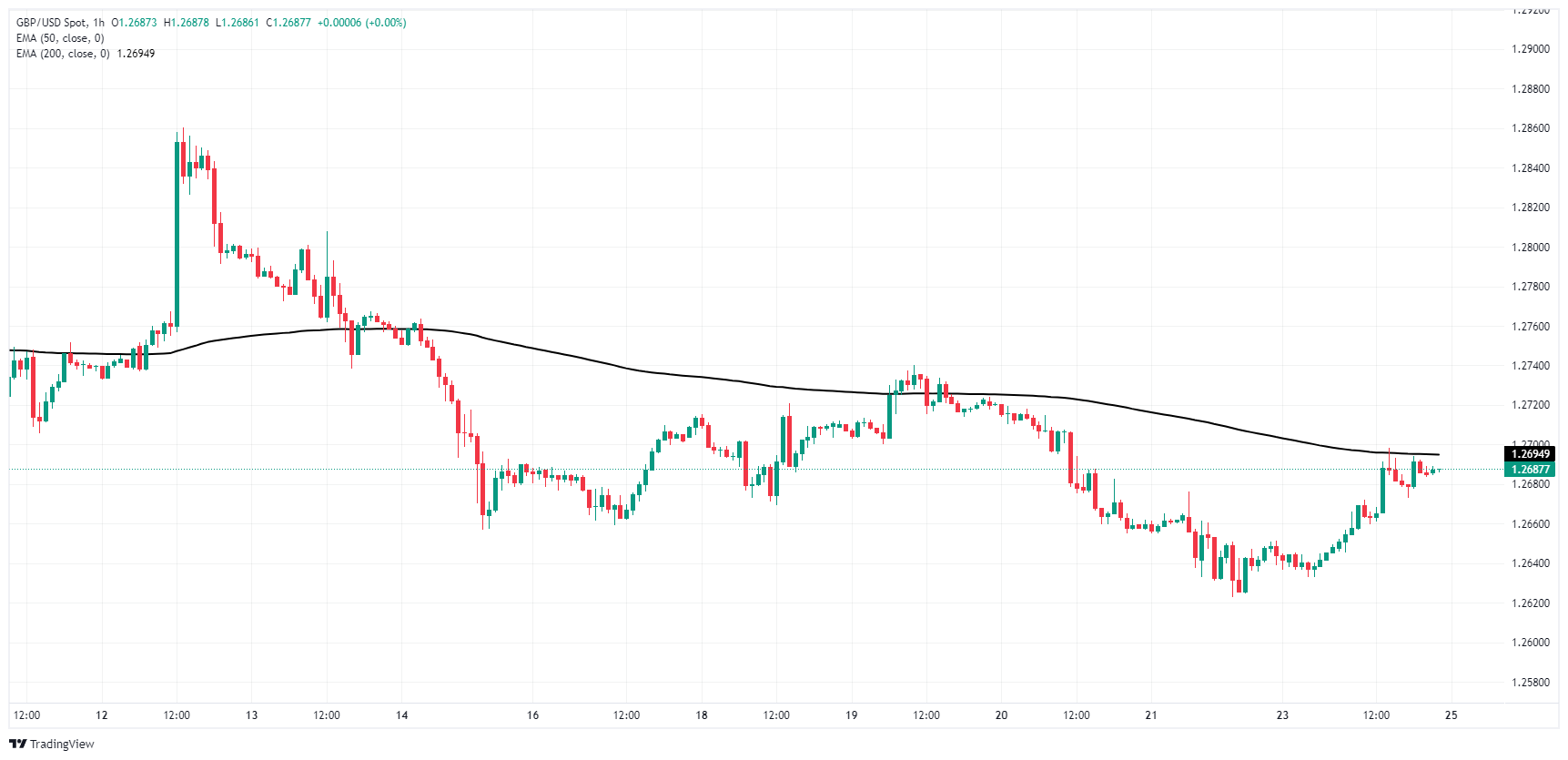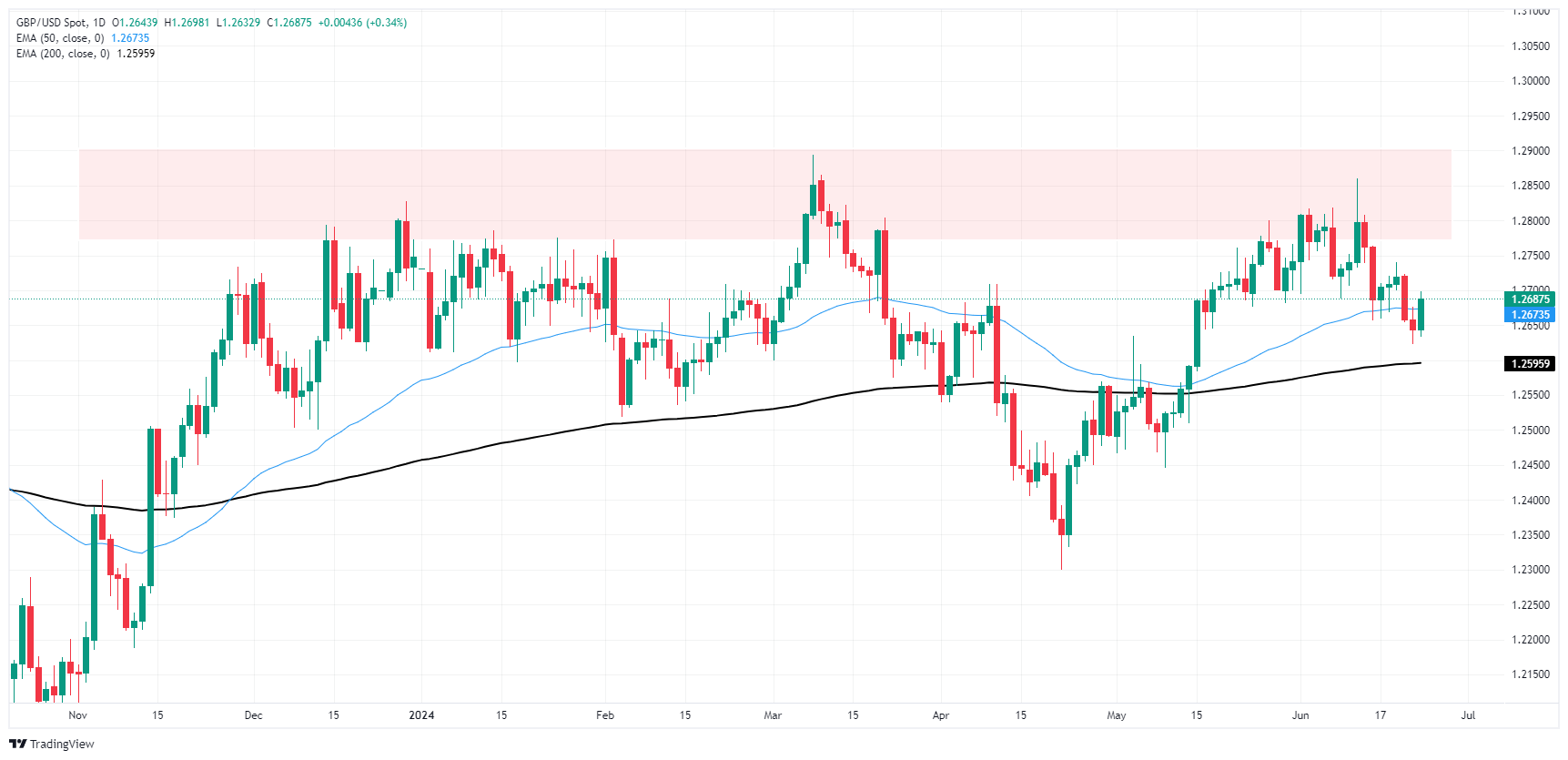- Phân tích
- Tin tức và các công cụ
- Tin tức thị trường
- GBP/USD looks for an extended pickup from latest downturn
GBP/USD looks for an extended pickup from latest downturn
- GBP/USD drifts higher on Monday amidst a thin early-week economic calendar.
- UK GDP data due at the end of the week, strictly mid-tier releases on offer until then.
- Fed news cycle to dominate market attention as policymakers caution restraint.
GBP/USD ground out some bullish chart paper on Monday, climbing from a recent swing low into 1.2650 as markets kicked off the new trading week with risk appetite firmly on the front foot. Key economic data remains limited through most of the week, with Cable traders set to look ahead to high-impact calendar releases that won’t land until later. Gross Domestic Product (GDP) updates for the US and the UK are due in the back half of the trading week, with US Personal Consumption Expenditure (PCE) Price Index inflation numbers slated for Friday.
Fed's Daly: Inflation is not the only risk, but recent inflation readings are more encouraging
Fed's Goolsbee: Slowing inflation data would open door to easier policy
Tuesday's release schedule is strictly mid-tier, leaving markets to churn on statements from central bank policymakers. A smattering of Fedspeak comments sent minor jitters through Monday's markets, with more of the same expected on Tuesday.
Federal Reserve Bank of San Francisco President Mary Daly noted on Monday that 2024’s inflation prints have not inspired much confidence when viewed in the aggregate, though recent prints have shown promise. Fed policymaker Daly’s comments followed on the heels of earlier comments from Federal Reserve Bank of Chicago President Austan Goolsbee, who remains optimistic that further progress on inflation will be forthcoming, noting that the Fed’s policy stance remains appropriately restrictive.
GBP/USD technical outlook
The Cable’s Monday bull run drove the pair up six-tenths of one percent bottom-to-top from last Friday’s bottom bids at 1.2622. Hourly candles have tipped into technical resistance at the 200-hour Exponential Moving Average (EMA) at 1.2695, which could be a bump in the road for bullish momentum.
Daily candlesticks are churning in neutral territory just north of the 200-day EMA at 1.2603, and further downside could be on the cards as intraday bids get hung up on the 50-day EMA at 1.2673.
GBP/USD hourly chart
GBP/USD daily chart
Pound Sterling FAQs
The Pound Sterling (GBP) is the oldest currency in the world (886 AD) and the official currency of the United Kingdom. It is the fourth most traded unit for foreign exchange (FX) in the world, accounting for 12% of all transactions, averaging $630 billion a day, according to 2022 data. Its key trading pairs are GBP/USD, aka ‘Cable’, which accounts for 11% of FX, GBP/JPY, or the ‘Dragon’ as it is known by traders (3%), and EUR/GBP (2%). The Pound Sterling is issued by the Bank of England (BoE).
The single most important factor influencing the value of the Pound Sterling is monetary policy decided by the Bank of England. The BoE bases its decisions on whether it has achieved its primary goal of “price stability” – a steady inflation rate of around 2%. Its primary tool for achieving this is the adjustment of interest rates. When inflation is too high, the BoE will try to rein it in by raising interest rates, making it more expensive for people and businesses to access credit. This is generally positive for GBP, as higher interest rates make the UK a more attractive place for global investors to park their money. When inflation falls too low it is a sign economic growth is slowing. In this scenario, the BoE will consider lowering interest rates to cheapen credit so businesses will borrow more to invest in growth-generating projects.
Data releases gauge the health of the economy and can impact the value of the Pound Sterling. Indicators such as GDP, Manufacturing and Services PMIs, and employment can all influence the direction of the GBP. A strong economy is good for Sterling. Not only does it attract more foreign investment but it may encourage the BoE to put up interest rates, which will directly strengthen GBP. Otherwise, if economic data is weak, the Pound Sterling is likely to fall.
Another significant data release for the Pound Sterling is the Trade Balance. This indicator measures the difference between what a country earns from its exports and what it spends on imports over a given period. If a country produces highly sought-after exports, its currency will benefit purely from the extra demand created from foreign buyers seeking to purchase these goods. Therefore, a positive net Trade Balance strengthens a currency and vice versa for a negative balance.
© 2000-2024. Bản quyền Teletrade.
Trang web này được quản lý bởi Teletrade D.J. LLC 2351 LLC 2022 (Euro House, Richmond Hill Road, Kingstown, VC0100, St. Vincent and the Grenadines).
Thông tin trên trang web không phải là cơ sở để đưa ra quyết định đầu tư và chỉ được cung cấp cho mục đích làm quen.
Giao dịch trên thị trường tài chính (đặc biệt là giao dịch sử dụng các công cụ biên) mở ra những cơ hội lớn và tạo điều kiện cho các nhà đầu tư sẵn sàng mạo hiểm để thu lợi nhuận, tuy nhiên nó mang trong mình nguy cơ rủi ro khá cao. Chính vì vậy trước khi tiến hành giao dịch cần phải xem xét mọi mặt vấn đề chấp nhận tiến hành giao dịch cụ thể xét theo quan điểm của nguồn lực tài chính sẵn có và mức độ am hiểu thị trường tài chính.
Sử dụng thông tin: sử dụng toàn bộ hay riêng biệt các dữ liệu trên trang web của công ty TeleTrade như một nguồn cung cấp thông tin nhất định. Việc sử dụng tư liệu từ trang web cần kèm theo liên kết đến trang teletrade.vn. Việc tự động thu thập số liệu cũng như thông tin từ trang web TeleTrade đều không được phép.
Xin vui lòng liên hệ với pr@teletrade.global nếu có câu hỏi.















